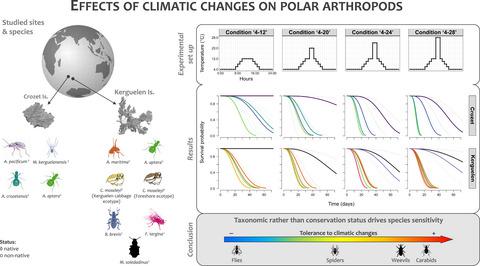当前位置:
X-MOL 学术
›
Glob. Change Biol.
›
论文详情
Our official English website, www.x-mol.net, welcomes your feedback! (Note: you will need to create a separate account there.)
The rising threat of climate change for arthropods from Earth's cold regions: Taxonomic rather than native status drives species sensitivity
Global Change Biology ( IF 11.6 ) Pub Date : 2022-07-11 , DOI: 10.1111/gcb.16338 David Renault 1 , Camille Leclerc 1, 2 , Marc-Antoine Colleu 1 , Aude Boutet 1 , Hoel Hotte 1, 3 , Hervé Colinet 1 , Steven L Chown 4 , Peter Convey 5, 6
Global Change Biology ( IF 11.6 ) Pub Date : 2022-07-11 , DOI: 10.1111/gcb.16338 David Renault 1 , Camille Leclerc 1, 2 , Marc-Antoine Colleu 1 , Aude Boutet 1 , Hoel Hotte 1, 3 , Hervé Colinet 1 , Steven L Chown 4 , Peter Convey 5, 6
Affiliation

|
Polar and alpine regions are changing rapidly with global climate change. Yet, the impacts on biodiversity, especially on the invertebrate ectotherms which are dominant in these areas, remain poorly understood. Short-term extreme temperature events, which are growing in frequency, are expected to have profound impacts on high-latitude ectotherms, with native species being less resilient than their alien counterparts. Here, we examined in the laboratory the effects of short periodic exposures to thermal extremes on survival responses of seven native and two non-native invertebrates from the sub-Antarctic Islands. We found that survival of dipterans was significantly reduced under warming exposures, on average having median lethal times (LT50) of about 30 days in control conditions, which declined to about 20 days when exposed to daily short-term maxima of 24°C. Conversely, coleopterans were either not, or were less, affected by the climatic scenarios applied, with predicted LT50 as high as 65 days under the warmest condition (daily exposures at 28°C for 2 h). The native spider Myro kerguelensis was characterized by an intermediate sensitivity when subjected to short-term daily heat maxima. Our results unexpectedly revealed a taxonomic influence, with physiological sensitivity to heat differing between higher level taxa, but not between native and non-native species representing the same higher taxon. The survival of a non-native carabid beetle under the experimentally imposed conditions was very high, but similar to that of native beetles, while native and non-native flies also exhibited very similar sensitivity to warming. As dipterans are a major element of diversity of sub-Antarctic, Arctic and other cold ecosystems, such observations suggest that the increased occurrence of extreme, short-term, thermal events could lead to large-scale restructuring of key terrestrial ecosystem components both in ecosystems protected from and those exposed to the additional impacts of biological invasions.
中文翻译:

气候变化对地球寒冷地区节肢动物的威胁日益增加:分类而非原生状态驱动物种敏感性
随着全球气候变化,极地和高山地区正在迅速变化。然而,对生物多样性的影响,特别是对在这些地区占主导地位的无脊椎动物变温动物的影响,仍然知之甚少。预计频率不断增加的短期极端温度事件将对高纬度变温动物产生深远影响,本地物种的弹性不如外来物种。在这里,我们在实验室检查了短期周期性暴露于极端温度对来自亚南极群岛的七种本地和两种非本地无脊椎动物的生存反应的影响。我们发现,在变暖的环境下,双翅目的存活率显着降低,平均致死时间中位数(LT 50) 在控制条件下约 30 天,当暴露于 24°C 的每日短期最大值时下降至约 20 天。相反,鞘翅目不受或较少受到所应用气候情景的影响,预测的 LT 50在最温暖的条件下高达 65 天(每天在 28°C 下暴露 2 小时)。本地蜘蛛Myro kerguelensis当受到短期每日热量最大值时,其特征是中等敏感性。我们的结果出乎意料地揭示了分类学的影响,较高级别分类群对热的生理敏感性不同,但代表相同较高分类群的本地和非本地物种之间没有差异。在实验条件下,非本地甲虫的存活率非常高,但与本地甲虫相似,而本地和非本地苍蝇对变暖的敏感性也非常相似。由于双翅目是亚南极、北极和其他寒冷生态系统多样性的主要组成部分,这些观察表明极端、短期、
更新日期:2022-07-11
中文翻译:

气候变化对地球寒冷地区节肢动物的威胁日益增加:分类而非原生状态驱动物种敏感性
随着全球气候变化,极地和高山地区正在迅速变化。然而,对生物多样性的影响,特别是对在这些地区占主导地位的无脊椎动物变温动物的影响,仍然知之甚少。预计频率不断增加的短期极端温度事件将对高纬度变温动物产生深远影响,本地物种的弹性不如外来物种。在这里,我们在实验室检查了短期周期性暴露于极端温度对来自亚南极群岛的七种本地和两种非本地无脊椎动物的生存反应的影响。我们发现,在变暖的环境下,双翅目的存活率显着降低,平均致死时间中位数(LT 50) 在控制条件下约 30 天,当暴露于 24°C 的每日短期最大值时下降至约 20 天。相反,鞘翅目不受或较少受到所应用气候情景的影响,预测的 LT 50在最温暖的条件下高达 65 天(每天在 28°C 下暴露 2 小时)。本地蜘蛛Myro kerguelensis当受到短期每日热量最大值时,其特征是中等敏感性。我们的结果出乎意料地揭示了分类学的影响,较高级别分类群对热的生理敏感性不同,但代表相同较高分类群的本地和非本地物种之间没有差异。在实验条件下,非本地甲虫的存活率非常高,但与本地甲虫相似,而本地和非本地苍蝇对变暖的敏感性也非常相似。由于双翅目是亚南极、北极和其他寒冷生态系统多样性的主要组成部分,这些观察表明极端、短期、


























 京公网安备 11010802027423号
京公网安备 11010802027423号